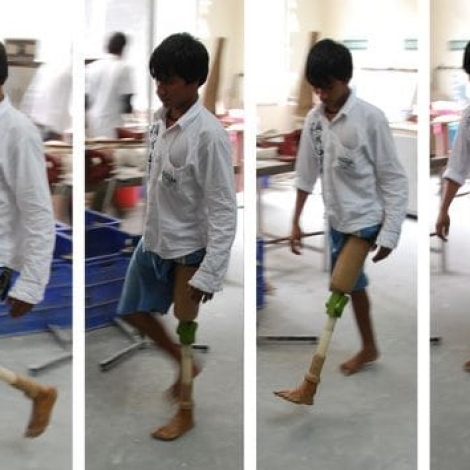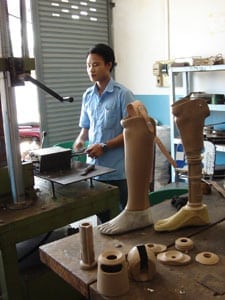Prosthetic limb design is pushing the bounds of technological prowess with advances like shape-changing materials, robotics and bone grafting. But most of the world’s amputees live in developing countries and that kind of technology is unattainable. For that overlooked majority, some prosthesis designers are nudging the technology toward the opposite extreme: low cost and simplicity, but without sacrificing quality.
Cheap, durable prosthetic knees that can withstand humid tropical climates, dusty roads and muddy fields can change a leg-amputee’s life. Re:Motion, a former research team at Stanford University and a technology incubator at the design firm Design Revolution, is one of a handful of enterprises that are developing prosthetic knees for sale in developing countries. (We reported last year on another prosthetic knee design. the LEGS M1.)

The Jairpurknee is made of five plastic pieces and four fasteners for easy manufacture and maintenance. Photo courtesy of D-Rev
Field tested
Re:Motion’s prosthetic, called JaipurKnee, costs roughly $20 to produce. To keep the price so low, the knee is made of only five plastic pieces and four fasteners. The pieces are easy to mass produce and assemble.
In spite of that simplicity, the knee is an upgrade over its competition on the market now. JaipurKnee is polycentric, not hinged like the other cheap prosthetics in its market. That allows for movement in multiple directions, more like the flesh and bone that it replaces. Its design aims for stability and efficiency in the step.
Jaipurknee is undergoing field testing now with nearly 2500 patients outfitted. Most of the tests are in India at BMVSS, a foot clinic in Jaipur. The BMVSS organization has also fit the knees to patients in temporary camps in Iraq, Sri Lanka, and Senegal.
“Field trials are ongoing in India and other locations,” says Krista Donaldson, head of D-Rev. “We are iterating the design based on input from users and what makes the most sense for commercialization. We have new designs underway, but they are still in the prototype stage.”

The Jairpurknee tries to mimic a knee to allow for natural movement. Photo courtesy of D-Rev
How E4C can help
D-Rev is preparing to take the tested designs to market by the end of the year. As the team prepares to commercialize, they realize there may be a hitch: The markets for prostheses in developing countries are apparently fragmented, Donaldson says.
That’s where the E4C community may be able to help. “If there are community members who have contact with large organizations that distribute or fit prosthetics in low-resource areas, we’d like to hear from them,” Donaldson says.
When the knee goes to market, it will be available to clincs and aid groups as a low-cost solution. But before then, charitable groups and even distributors may have a shot at getting their hands on early copies. “While trials are ongoing, we would definitely consider new potential partners on a case-by-case basis,” Donaldson says.


Hi,
My name is Jonathan Vinton. I’ve been looking all over the internet for low cost, durable, and functional prosthesis. I grew up in a village in the Iringa region of Tanzania. There are several amputees in my village and the current prosthesis have multiple problems (poor design.) Is there any chance that I could discuss with you how your product is produced and designed? I’m not looking to profit off of this, I am looking to help those in my village and across the developing world.
Thank you for your time,
Jonathan Vinton